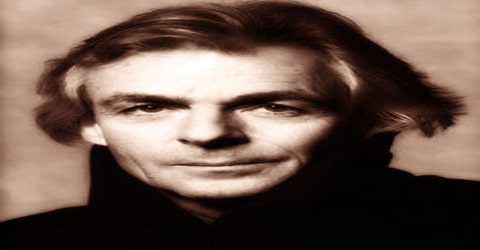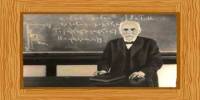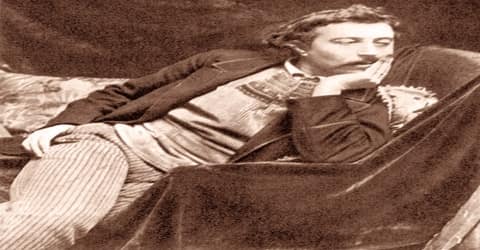Biography of Joseph Louis Lagrange
Joseph Louis Lagrange – A famous mathematician and astronomer.
Name: Joseph Louis Lagrange
Date of Birth: 25 January 1736
Place of Birth: Turin, Piedmont-Sardinia, Italy
Date of Death: 10 April 1813 (aged 77)
Place of Death: Paris, France
Occupation: Mathematician, Astronomer
Father: Giuseppe Francesco Lodovico Lagrange
Mother: Maria Theresa Gros
Spouse/Ex: Vittoria Conti (m. 1767), Renee-Francoise-Adelaide Le Monnie (m. 1792)
Early Life
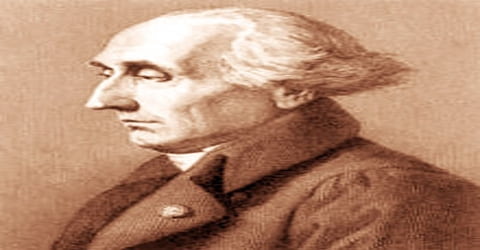
An Italian French mathematician who made great contributions to number theory and to analytic and celestial mechanics, Joseph-Louis Lagrange was born on 25 January 1736, in Turin, Piedmont-Sardinia. Born at the beginning of the 18th century, this Italian-born scientist was one of the greatest minds of his time. He made significant contributions to the fields of analysis, number theory, and both classical and celestial mechanics. His most important book, Mécanique analytique (1788; “Analytic Mechanics”), was the basis for all later work in this field.
His great-grandfather had moved to Turin from France and went on to marry an Italian woman. Being such a brilliant mind, Joseph is claimed by both Italy and France as a citizen. His initial steps in his journey into education saw him sent in school to study law. While in university, he was captivated by a paper written by Edmond Halley, who was an English mathematician and astronomer. Joseph’s interest in mathematics prompted him to start studying the subject on his own.
As a young man, Lagrange was sent to the University of Turin to study law but by a quirk of fate, he came across a paper by Edmond Halley, the English astronomer-cum-mathematician and became engrossed in it. Subsequently, he began to study mathematics on his own. His first paper was published at the age of eighteen and by nineteen he became an assistant professor of mathematics at the Royal Military Academy, Turin. Later he was invited to Berlin Academy, where he served for twenty years. Thereafter, he joined Académie des Sciences, Paris, on the invitation of Louis XVI and remained there till the end of his career. He was honored by both the aristocracy and the revolutionary governments that took over the reign after the French Revolution. He was made a Senator by Napoleon.
Childhood, Family and Educational Life
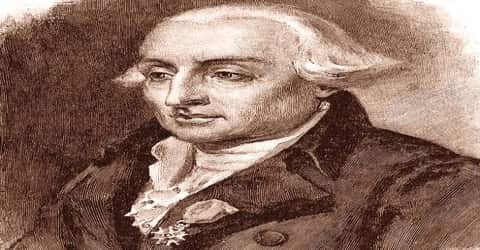
Joseph-Louis Lagrange, Comte de l’Empire, original Italian Giuseppe Luigi Lagrangia (/ləˈɡrɑːndʒ/ or /ləˈɡreɪndʒ/; French: lagʁɑ̃ʒ; born Giuseppe Luigi Lagrangia or Giuseppe Ludovico De la Grange Tournier; also reported as Giuseppe Luigi Lagrange or Lagrangia), was born on 25 January 1736 in Turin, Italy. His father, Giuseppe Francesco Lodovico Lagrangia, worked as a Treasurer in the Office of Public Works and Fortifications in Turin. His mother, Teresa Grosso, was the daughter of a doctor from a nearby town of Cambiano.
Lagrange was the eldest of his parent’s two surviving children. As a young man, he often used the French form of his family name, calling himself Lodovico LaGrange. He enrolled at the University of Turin to study law. Initially, he did not show much interest in mathematics. In fact, he found Greek geometry rather dull and was more interested in Classic Latin. At the age of seventeen, he accidentally came across a paper on the use of algebra in optics by Edmond Halley. It opened a new world for him.
Lagrange’s initial study into mathematics was all by his own and studied by himself for a year. The youngster was so good, that he published his first paper on 23rd July 1754. This initial publication, he later realized, was already circulated by two other scientists. With the threat looming that he may face accusations of copying someone’s work, he pushed even harder to come up with something unique and original. Joseph’s next piece was the theory that laid the foundation for the study of calculus, and he sent it to Leonhard Euler, a Swiss mathematician. Lagrange’s appointment as an assistant professor of mathematics came about in September 1755. The brilliant young man was only 19 years old at the time.
Although Lagrange’s father worked at a high position he lost a lot of money in financial speculation as a result of which, the family was constantly under financial distress. Lagrange had later said, had they had enough money he would not have enrolled at Turin University and study mathematics.
Personal Life
Joseph-Louis Lagrange married his cousin Vittoria Conti in 1967. They did not have any children. From his letters to d’Alembert, some scholars have deduced that he did not wish to have any. Vittoria died in 1783 after years of illness and Lagrange was very depressed.
In 1792, Joseph-Louis Lagrange married 24-year-old Renee-Francoise-Adelaide Le Monnier, the daughter of his colleague, Pierre Charles Le Monnier. It is said that she insisted that he marry her and was very devoted until his death on 10 April 1813 in Paris. They had no children.
In 1802, Lagrange became a French citizen. Lagrange attended Roman Catholic mass regularly, although otherwise seems to have had said little about his religion.
Career and Works
On 28 September 1755, Joseph-Louis Lagrange was appointed as the ‘Sostituto del Maestro di Matematica’ (assistant professor in mathematics) at the Royal Military Academy of the Theory and Practice of Artillery by Charles Emmanuel III, the Duke of Savoy and the King of Sardinia. Thus he began his career at the age of 19. At the Academy, he taught calculus and mechanics. Although he became well-known for the originality of his thoughts and depth of knowledge, his teaching style was not very popular. His abstract reasoning, as well as his impatience with engineering applications, also created problems.

With such a brilliant start to his mathematics and teaching career, he published numerous papers on various facets of science such as calculus of variations, linear differential equations, calculus of probabilities, and the foundations of dynamics. This great mathematician would also make significant contributions to fluid mechanics and the study of sound on orbits of various planets. Lagrange’s work on multiple areas of mathematics would see him honored with accolades and positions of authority by the ruling governments of his time. The development of the metric system was one of his most significant contributions to science, with the introduction of the meter and kilogram as units of measurement.
Lagrange is one of the founders of the calculus of variations. Starting in 1754, he worked on the problem of tautochrone, discovering a method of maximizing and minimizing functionals in a way similar to finding extrema of functions. Lagrange wrote several letters to Leonhard Euler between 1754 and 1756 describing his results. He outlined his “δ-algorithm”, leading to the Euler-Lagrange equations of variational calculus and considerably simplifying Euler’s earlier analysis. Lagrange also applied his ideas to problems of classical mechanics, generalizing the results of Euler and Maupertuis. Euler was very impressed with Lagrange’s results. It has been stated that “with characteristic courtesy, he withheld a paper he had previously written, which covered some of the same ground, in order that the young Italian might have time to complete his work, and claim the undisputed invention of the new calculus”; however, this chivalric view has been disputed. Lagrange published his method in two memoirs of the Turin Society in 1762 and 1773.
In 1757, Lagrange formed a scientific society in Turin, which later came to know as Royal Academy of Sciences of Turin. It published a scientific journal called ‘Mélanges de Turin’, in which Lagrange sent regular contributions. Lagrange’s work during this period covered a variety of topics, such as calculus of variations, calculus of probabilities and foundations of dynamics. Later, he also worked on fluid mechanics, linear differential equations, and propagation of sound as well as on orbits of planets like Jupiter and Saturn.
By 1761 Lagrange was already recognized as one of the greatest living mathematicians. In 1764 he was awarded a prize offered by the French Academy of Sciences for an essay on the libration of the Moon (i.e., the apparent oscillation that causes slight changes in the position of lunar features on the face that the Moon presents to the Earth). In this essay, he used the equations that now bear his name. His success encouraged the academy in 1766 to propose, as a problem, the theory of the motions of the satellites of Jupiter. The prize was again awarded to Lagrange, and he won the same distinction in 1772, 1774, and 1778. In 1766, on the recommendation of Euler and the French mathematician Jean d’Alembert, Lagrange went to Berlin to fill a post at the academy vacated by Euler, at the invitation of Frederick the Great, who expressed the wish of “the greatest king in Europe” to have “the greatest mathematician in Europe” at his court.
The 20 years Lagrange spent in Berlin were his most productive. Although at times he had to stop work because of ill-health, when his health was good, he published original, valuable papers at the rate of about one a month. Most were published by the Berlin Academy, while others appeared in two further volumes of Mélanges de Philosophie et de Mathématique.
In 1772, Lagrange returned to a problem that intrigued him the three-body problem in gravity. His treatise on the subject, Essai sur le Problème des Trois Corps, led to him again winning the French Academy of Sciences Prize. He considered a situation in which there are two relatively high mass objects, such as the earth and sun, orbiting a mutual center of gravity. Lagrange identified five balance points, the Lagrangian points L1, L2, L3, L4, and L5. Objects at these points hold their position relative to the two larger masses. (Euler identified the points L1, L2, and L3, a few years earlier in a less thorough analysis.) Today NASA’s Solar and Heliospheric Observatory Satellite is located at the earth-sun L1 point, allowing the sun to be viewed without interruption from a stable platform. The James Webb Space Telescope, the successor to the Hubble Space Telescope, is scheduled to be placed at the earth-sun L2 point in 2020.
In 1781, Lagrange was invited to take up the position of the Director of Philosophy at the Naples Academy by the Count of Naples. However, Lagrange wanted to concentrate only on mathematics and the Berlin Academy gave him ample opportunity so he refused the offer. In 1786, King Frederick the Great died and with that Lagrange’s position at the Berlin Academy became less comfortable as many of his colleagues had always envied him for he became the director at such a young age. Many Italian states now tried to lure him back to Italy. Around that time, he received an offer from Académie des Sciences, Paris, which exempted him from teaching. On 18 May 1787, Lagrange left Berlin for Paris and subsequently became a member of the Académie and remained there for the rest of his career.
His productivity in those years was prodigious: Lagrange published papers on the three-body problem, which concerns the evolution of three particles mutually attracted according to Sir Isaac Newton’s law of gravity; differential equations; prime number theory; the fundamentally important number-theoretic equation that has been identified (incorrectly by Euler) with John Pell’s name; probability; mechanics; and the stability of the solar system. In his long paper “Réflexions sur la résolution algébrique des équations” (1770; “Reflections on the Algebraic Resolution of Equations”), he inaugurated a new period in algebra and inspired Évariste Galois to his group theory.
Although Lagrange wrote his masterpiece Mécanique analytique (Analytical Mechanics), in Berlin, it was not published until 1788, after he had moved to Paris at the invitation of the French Academy of Sciences. At the beginning of his residence in Paris, he was seized with an attack of melancholy, and even the printed copy of his Mécanique on which he had worked for a quarter of a century lay for more than two years unopened on his desk. Curiosity as to the results of the French revolution first stirred him out of his lethargy, a curiosity which soon turned to alarm as the revolution developed.
The Revolution, which began in 1789, pressed Lagrange into work on the committee to reform the metric system. When the great chemist Antoine-Laurent Lavoisier was guillotined, Lagrange commented, “It took them only an instant to cut off that head, and a hundred years may not produce another like it.” When the École Centrale des Travaux Publics (later renamed the École Polytechnique) was opened in 1794, he became, with Gaspard Monge, its leading professor of mathematics. His lectures were published as Théorie des fonctions analytiques (1797; “Theory of Analytic Functions”) and Leçons sur le calcul des fonctions (1804; “Lessons on the Calculus of Functions”) and were the first textbooks on real analytic functions. In them Lagrange tried to substitute an algebraic foundation for the existing and problematic analytic foundation of calculus although ultimately unsuccessful, his criticisms spurred others to develop the modern analytic foundation. Lagrange also continued to work on his Mécanique analytique, but the new edition appeared only after his death.
In 1795, Lagrange was appointed to a mathematical chair at the newly established École Normale, which enjoyed only a brief existence of four months. His lectures there were quite elementary, and contain nothing of any special importance, but they were published because the professors had to “pledge themselves to the representatives of the people and to each other neither to read nor to repeat from memory,” and the discourses were ordered to be taken down in shorthand to enable the deputies to see how the professors acquitted themselves.
Awards and Honor
Joseph-Louis Lagrange was awarded several prizes by the Académie des Sciences. In 1764, he received the prize for his work on lunar libration; in 1766, for his work on the orbit of the Jupiter’s moons and in 1780, for his work on perturbations of the orbits of comets.
Lagrange was elected a Member of the Berlin Academy in 1756, a Fellow of the Royal Society of Edinburgh in 1790, Fellow of the Royal Society and Foreign Member of the Royal Swedish Academy of Sciences in 1806.
In 1808, Napoleon honored the aging mathematician, making him a senator and a count of the empire, but he remained the quiet, unobtrusive academician, a venerable figure wrapped in his thoughts.
In 1813, a week before his death, Lagrange was awarded the Grand Croix of the OrdreImpérial de la Réunion.
Death and Legacy
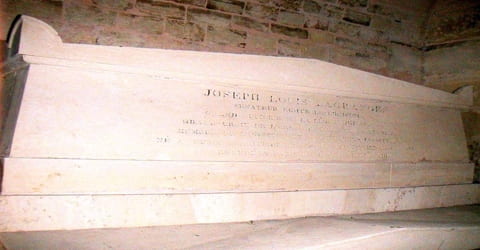
Joseph-Louis Lagrange died, age 77, on April 10, 1813, in Paris, France. Survived by his wife Renée, he was buried in the Panthéon, the final resting place of many eminent people including Voltaire, Victor Hugo, Lazare Carnot, Marcellin Berthelot, Paul Langevin, and Pierre & Marie Curie. The inscription on his tomb reads in translation:
JOSEPH LOUIS LAGRANGE. Senator. Count of the Empire. Grand Officer of the Legion of Honour. Grand Cross of the Imperial Order of the Reunion. Member of the Institute and the Bureau of Longitude. Born in Turin on 25 January 1736. Died in Paris on 10 April 1813.
Lagrange is best known for his contribution to the development of the metric system. As President of la Commission des Poids et Mesures, he played a decisive role in taking up the unit system of meter and kilogram as well as their decimal subdivisions. He is also considered as one of the founders of the calculus of variations. While working on the problem of tautochrone, he discovered a method of maximizing and minimizing functional, which led to the development of the calculus of variation. ‘Mécaniqueanalytique’, published in 1788, is another of his important work. He worked on this book for half a century and summarized all the work done in the field of mechanics since the time of Newton.
As a mathematician, Lagrange was obsessed with discovering unique theories and concepts of mathematics. This pursuit for discoveries remained motivated by endless imagination, hard work, and interest in a wide range of branches of mathematics. The self-drive demonstrated in his research and discoveries ensured the foundations for many areas of mathematics. It is important to note that for excellence and innovation, self-discipline and the urge to pursue a wide range of interests remains very important.
When the Eiffel Tower opened in 1889, Lagrange was one of the 72 French scientists, engineers, and mathematicians whose names were engraved on plaques on the tower.
Information Source:


